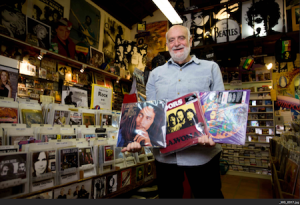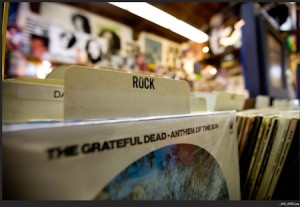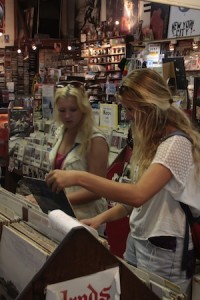
The look and, actually, the smell of the Sound Spectrum, a kitschy and practically prehistoric record shop on South Coast Highway, haven’t changed that much over the last 45 years. But if you look past the looming wall-size (and out-of-print) collector’s posters of Hendrix, The Beatles, Bob Marley and The Clash overhead, you’ll see something you might wish you still had your hands on.
Where once only CDs prevailed, vinyl albums, largely classic rock-and-roll with some price tags upwards of $30, are back where they belong, nestled in the wooden display racks custom-built to hold them lo all those years ago.
The records are returning to the racks not out of nostalgia or because of collectible cover-art, although both attributes come into play as reasons for the vinyl revival. It’s because they’re surprisingly attracting a younger generation of buyers who seem intrigued by what their parents had been up to.
What they found was a fuller sound, subtler than the fast-food version of music bytes they’d been fed most of their formative years, digitized and downloaded from the Internet.
Twenty-somethings and younger have become the largest demographic buying vinyl, according to Forbes, with the Beatles’ “Abbey Road” placing first in sales last year. Vinyl albums sales rose 36 percent in 2011 to 3.9 million, their highest level since 1991 when Nielsen SoundScan started collecting sales data from retailers. Forbes has predicted that vinyl will eventually outsell CDs, a trend that’s saving independent record stores from fading into oblivion.
“At a certain point, I probably would have closed,” said Jim Otto, the Sound Spectrum’s original owner since 1967. Buying the building at his parents’ insistence back then, Otto finally feels it was the right decision. “I was able to hang in here even though it probably wasn’t practical,” he said about a time when even the towers of power in record stores were calling it quits. “At a certain point, I was just barely breaking even,” he said. “With Laguna, at least you’re lucky enough because summertime brings in an influx of people.”
For now, even a hint of increasing sales is sweet. Revenue from recorded music shrunk 52 percent from 2000 to 2010, according to the Recording Industry Association of America.
But last year things started looking up with 1.27 billion individual tracks downloaded in the U.S., up 8.5 percent from 2010, and sales of complete digital albums reaching 103.1 million, a 19.5 percent gain, according to Nielsen.

The big news for the little store is that for the fourth consecutive year, more vinyl records were sold than in any other quantified era, according to Nielsen, with two-thirds of those albums purchased at independent music retailers. And that’s counting only newly pressed releases or re-releases, not vintage vinyl.
Otto’s expecting to see high-quality used original albums grow in demand and is happily removing dividers that converted his record bins to hold CDs, already filling two double-sided rows down the center of his musicology enclave with album sleeves from the past.
“Vinyl will definitely outlast CDs because of the resonance, the sound,” Warner Group’s Recorded Music CEO Lyor Cohen told Forbes in January. “The quality is closest to the way the artist wants you to hear it.”
Sound is a big factor with the heretofore-digitized generation but so is physicality. “Vinyl is vintage,” a definite “cool” factor, said Jackson Parker, 17, a well-versed music enthusiast. But what’s attracting his generation to the plate-size platters is “they’re tangible,” he said.
Parker Macy, 27, owner of a pint-size silver and baby-blue Airstream-type trailer converted to a retro music shack at The Lab in Costa Mesa, agrees. “I think having 12½ inches square of big material you can stare at and look at and touch and feel inspires people to collect rather than just filing stuff in a folder on your computer,” he says. “It’s a lot more hands-on and kids are hands-on people. We all are.”
There is the argument that downloaded digitized music can be upgraded comparable to vinyl quality, but album collectors turn a deaf ear. “You can make a robot that’s almost a human but the fact of the matter is it’s never going to be a human,” says Macy.
Digital, let’s face it, is convenient. It’s hard to take an LP on a jog or a jet or in a car, for that matter. Macy said he has a couple of hundred gigabytes of MP3s to choose from when he rides his bike. “They’re great for their convenience but the quality is just so dumbed-down, it’s almost not worth listening to after awhile,” he said. “People who want to hear the intricacies of the record, hear the trumpets pop out over the clarinets, you’re going to hear it in its element a helluva lot better on a record.”
All in all, vinyl fans are figuring out that the industry had it right when 33’s rolled off the presses.
“They told us CDs would sound better; they didn’t,” said Wave Baker, a long-haired, well-preserved hippie and music junkie who’s worked with Otto for more than 12 years. “Downloads are convenient but I don’t think people would have let go of their vinyl if they knew they would sound better. I know a lot of people who have and they’re sorry.




